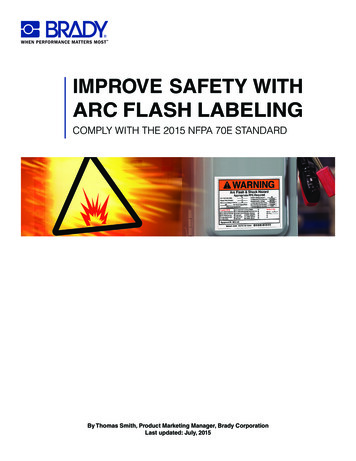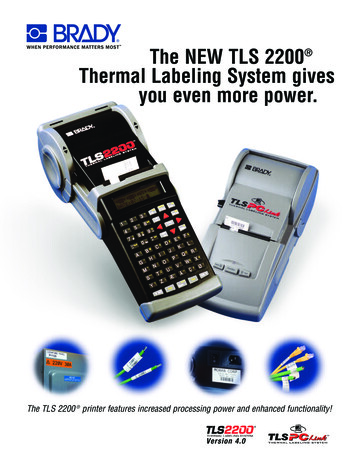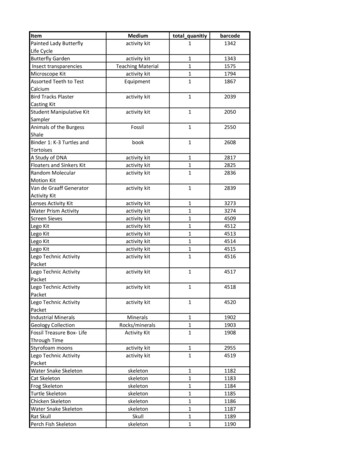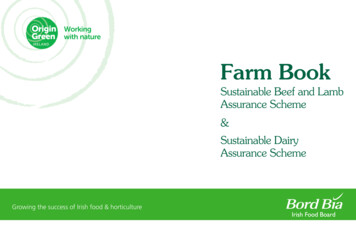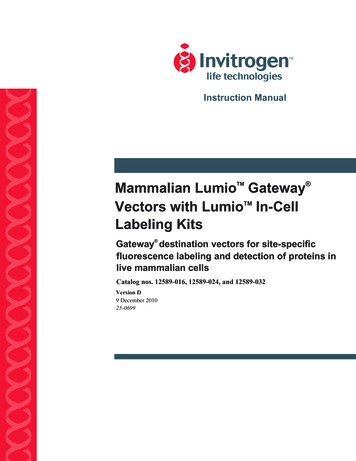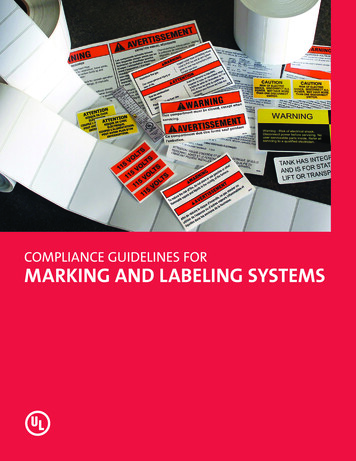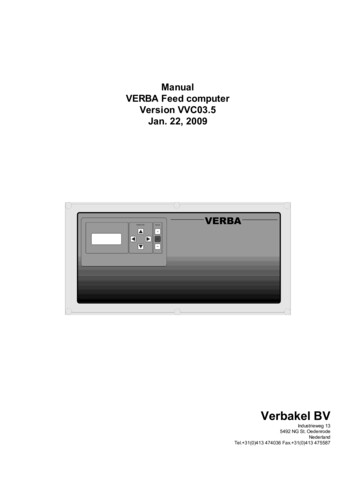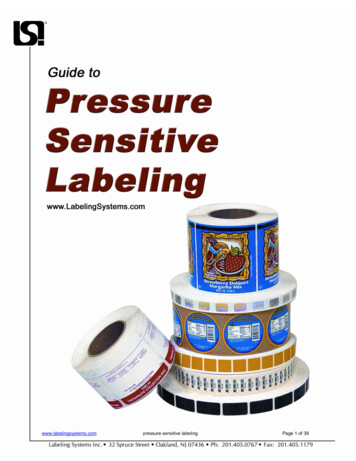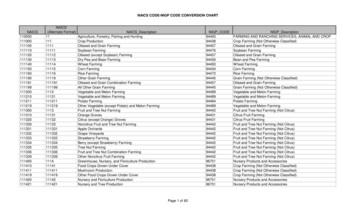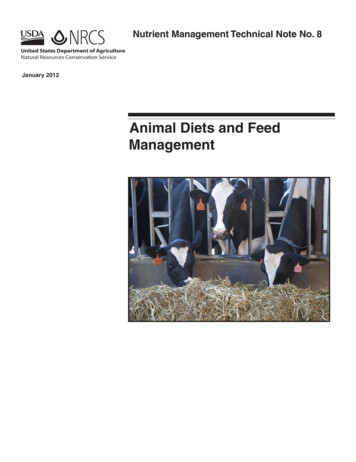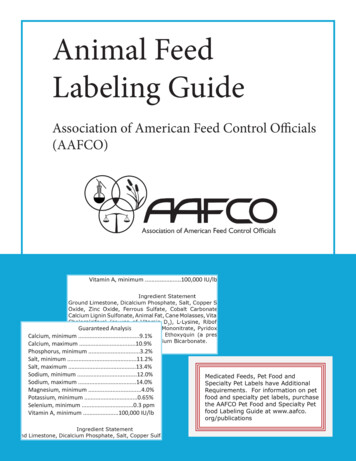
Transcription
Animal FeedLabeling GuideAssociation of American Feed Control Officials(AAFCO)Medicated Feeds, Pet Food andSpecialty Pet Labels have AdditionalRequirements. For information on petfood and specialty pet labels, purchasethe AAFCO Pet Food and Specialty Petfood Labeling Guide at www.aafco.org/publications
August 2020CONTENTSIntroduction . . . . . . . . . . . . . . . . . . . . . . . . . . . . . . . . . . . . . . . . . . . . . . . . . 1Acronyms and Abbreviations. . . . . . . . . . . . . . . . . . . . . . . . . . . . . . . . . . . . . 2Label Design and Required Elements . . . . . . . . . . . . . . . . . . . . . . . . . .Commercial Feed Labels. . . . . . . . . . . . . . . . . . . . . . . . . . . . . . . . .Single Ingredient Product Labels. . . . . . . . . . . . . . . . . . . . . . . . . . .Customer Formula Feed Labels. . . . . . . . . . . . . . . . . . . . . . . . . . . .Label Formatting for Commercial Feeds . . . . . . . . . . . . . . . . . . . . . . . .Product & Brand Names. . . . . . . . . . . . . . . . . . . . . . . . . . . . . . . . .Purpose Statement . . . . . . . . . . . . . . . . . . . . . . . . . . . . . . . . . . . .Guaranteed Analysis . . . . . . . . . . . . . . . . . . . . . . . . . . . . . . . . . . .When to State Guarantees. . . . . . . . . . . . . . . . . . . . . . . . . . .How to Express Guarantees . . . . . . . . . . . . . . . . . . . . . . . . . .Species-Specific Feeds and Supplements. . . . . . . . . . . . . . . . .Mineral Feeds. . . . . . . . . . . . . . . . . . . . . . . . . . . . . . . . . . . .Ingredient Statement. . . . . . . . . . . . . . . . . . . . . . . . . . . . . . . . . . . 4. 4. 5. 5. 5. 8101517Collective Terms . . . . . . . . . . . . . . . . . . . . . . . . . . . . . . . . . . . . . . . . . .Directions for Use and Precautionary Statements . . . . . . . . . . . . . . .Manufacturer or Distributor Name. . . . . . . . . . . . . . . . . . . . . . . . . .Net Quantity Statement. . . . . . . . . . . . . . . . . . . . . . . . . . . . . . . . .18181920Non-Medicated Feed Label Examples . . . . . . . . . . . . . . . . . . . . . . . . . .Commercial Feed Labeling . . . . . . . . . . . . . . . . . . . . . . . . . . . . . . .Single Ingredient Labeling . . . . . . . . . . . . . . . . . . . . . . . . . . . . . . .Customer Formula Feed Labeling. . . . . . . . . . . . . . . . . . . . . . . . . . .20213738Association of American Feed Control Officials (AAFCO)Headquarters Office1800 S. Oak Street, Suite 100Champaign, IL 61820-6974217-356-4221aafco@aafco.org3334
August 2020
August 2020INTRODUCTIONThe Association of American Feed Control Officials (AAFCO) is a voluntary membershiporganization that comprises personnel representing state and federal feed regulatoryagencies. The Association is advised by industry and consumer representatives withthe intent of designing feed regulations that provide fair and equitable commerce for allstakeholders. A major function of feed regulation is to safeguard the health of man andanimals and a critical component of that function is to ensure that animal feed and feedingredients are appropriately and safely used as provided by the product label.This booklet will provide you with the necessary basic information and guidelines so you candesign and produce commercial non-medicated feed labels that meet the AAFCO Model Billand Regulations. Labels addressed in this guide are for the various classes of food-producingand livestock animal non-medicated feeds and specialty product types that are fed to theseanimals, such as mineral premixes and free-choice feeds, and the labeling of some feedingredients.This guide does not address the labeling of pet food or specialty pet food. There is aseparate guide available for these products. For more information, please visitwww.aafco.org.Disclaimer About Varying State RequirementsThough some state feed regulatory agencies recognize the AAFCO Model Bill andRegulations, there may be additional requirements for feed labeling compliance that isspecific to their own law and regulations. Prior to distributing commercial feeds in any stateor territory, consult with the corresponding feed control official. For a contact list of feedcontrol officials, please visit www.aafco.org.The information included in this guide is derived from the 2018 AAFCO OP. For completelabeling information refer to the current edition of the AAFCO OP. To obtain the AAFCO OPgo to the AAFCO web site at http://www.aafco.org or contact Jennifer Roland, by phone:(217) 356-4221 or email: aafco@aafco.org.What is the purpose of a feed label?A commercial feed is nutritionally suitable for its intended use as represented by its labeling.A feed label allows the purchaser to select a product to meet their production needs. A labelprovides basic product information that would help the purchaser determine how to usethe product safely and obtain the best benefits and results. In addition, a label of uniformformat and composition provides a level field of play for both the purchaser and distributor.What information is on a feed label?A commercial feed label contains information describing the feed product and detailsnecessary for the safe and effective use of the feed. This includes product name, brand1
August 2020name (if applicable), a product purpose statement, levels of nutrients provided, theingredients used to make the feed, feeding directions (adequate directions for use), cautionsand/or warnings, manufacturer/distributor information (the person or firm responsible forthe feed), and net weight of the package, or contents of the container, if applicable.The information that is present on an animal feed label is based on many factors, such asthe intent of the product (single ingredient versus complete ration) or the species to whichthe product is intended to be fed. In addition, in some cases, dependent on the amount offeed, there may not be a traditional label as you would see printed on, or sewn to, a sack offeed, but perhaps it will be printed on the invoice or delivery slip. Regardless, all the labelinginformation discussed in this booklet is needed for the buyer to safely use the feed and mustbe present. Additionally, the AAFCO Model Bill defines the difference between a “commercialfeed”, “feed ingredient”, and “customer-formula feed”, and the necessary label informationfor these products varies as discussed later in this booklet.ACRONYMS AND ABBREVIATIONSAAFCO: Association of American Feed Control OfficialsADF: Acid Detergent FiberCFR: Code of Federal RegulationsCFU: Colony Forming UnitsFDA: Food and Drug Administrationg: gram(s)ICU: International Chick UnitsIU/lb: International units per poundkg: kilogram(s)l/L: liter(s)lb/lbs: pound(s)mg: milligram(s)ml/mL: milliliter(s)NDF: Neutral Detergent FiberNPN: Non-protein nitrogenOP: Official Publicationoz: ounce(s)ppm: parts per million2
August 2020LABEL DESIGN AND REQUIRED ELEMENTSCommercial Feed Labels(See examples of labels on page 21 to page 38)A commercial feed can be a feed ingredient or a combination of feed ingredients which aredistributed to be fed to animals. The label for each package or bulk delivery of commercialfeed products shall contain all of the following information in this specified order: The product name and its brand name, if any The purpose statement for the feed (identifying specific species and animalclass(es)) The guaranteed analysis statement The ingredient statement Directions for safe and effective use (commonly known as “Feeding Directions” or“Mixing Directions”) and any required precautionary statements to enable the safeuse of the product by users with no special knowledge of the purpose and use ofthe product. The manufacturer’s or distributor’s name and address A quantity or net weight statement, in both standard (avoirdupois) and metric unitsSingle Ingredient Product Labels(See example on page 37)A single ingredient, other than those exempted by the Model Bill and Regulations, is stillconsidered a “commercial feed”. However, with all the varieties of ingredients available witha multitude of purposes and uses, it is necessary to provide some information in order toensure correct labeling of these products. More information can be found after CommercialFeed Label Requirements. The label for each single ingredient feed shall contain all of thefollowing information: The product name and its branded name, if any The purpose statement “Single Feed Ingredient”, “Feed Ingredient” or “For FurtherManufacturing of Feed”, as appropriate The guaranteed analysis statement The ingredient statement if the ingredient is not used as the product name Directions for safe and effective use and required precautionary statements, if any The manufacturer’s or distributor’s name and address A quantity or net weight statement3
August 2020Customer Formula Feed Labels(See example on page 38)A “customer-formula feed” is a commercial feed which consists of a mixture of feedingredients and/or commercial feeds which is manufactured according to the specificinstructions of the customer. A customer-formula feed must be accompanied by theinformation listed below using a label, invoice, delivery ticket, or other shipping document.The label for each delivery of a “customer-formula feed” shall include: Manufacturer’s name and address Purchaser’s name and address Date of delivery or sale The customer-formula feed name and brand name, if any The complete name and net quantity of each commercial feed and each otheringredient used in the customer-formula feed Directions for use and precautionary statements, if requiredLABEL FORMATTING FOR COMMERCIAL FEEDSThese requirements are all expected to be listed on the product’s Principal Display Paneli.e., the outward facing side of the feed tag or the portion of the label most likely to bepresented and read under the normal conditions of display for retail sale.1. Product & Brand Names (Model Regulation 3(a)(1)) The product or brand name must be appropriate for the feed’s intended use andmay not be misleading in any way. If the product name indicates a specific purpose, the feed’s composition mustcorrespond to that (for example, starter, finisher or complete feed). The name of the feed cannot be comprised of the names of one or more of theingredients, unless all the ingredients used to make the feed are included in thefeed’s name. An ingredient or a combination of ingredients can be used in the product name if itimparts a specific characteristic to the product and that characteristic is significantto the product’s purchaser and are quantified by guarantees in the “GuaranteedAnalysis” statement. The word “protein” cannot be used in the product name if the feed contains anyadded “non-protein nitrogen”. If the product name contains a numerical or percentage value it will be referencedto the quantity of protein, unless it is otherwise noted.4 If the product or brand name contains the word “vitamin,” the feed must be avitamin supplement and the vitamin must be guaranteed in the “GuaranteedAnalysis” statement.
August 2020 The term “mineralized” can only be used for “trace mineralized salt”. The term “meat” and “meat by-products” shall be qualified to designate the animalfrom which the meat and meat by-products is derived unless the meat and meatby-products are made from cattle, swine, sheep, and goats.2. Purpose Statement (Model Regulation 3(a)(3)) A purpose statement provides the feed purchaser with information on the specificspecies and animal class(es) for which the feed is intended. The purpose statement may be excluded if the product or brand name identifies thespecies and class for which the product is intended. A manufacturer can be flexible with more specific and common language in orderto describe the animals, but must be consistent with the following categories ofanimal classes. The purpose statement for a premix for the further manufacture of feed mayexclude the animal class and species and state “For Further Manufacture of Feed” ifthe nutrients contained in the premix are guaranteed and sufficient for formulationinto various animal species feed and premix specifications are provided by the enduser of the premix.3. Guaranteed Analysis (Model Regulation 3(a)(4))When to State GuaranteesA required element of feed labels is the Guaranteed Analysis section. The nutrients orsubstances that must be guaranteed will vary with the intended use of the feed and by thespecific animal species and class.Specific Species and Animal ClassesSwine Animal Classes1.Pre-Starter — 2 to 11 pounds body weight2.Starter — 11 to 44 pounds body weight3.Grower — 44 to 110 pounds body weight4.Finisher — 110 pounds to market weight5.Gilts, Sows, and Adult Boars6.Lactating Gilts and SowsPoultry Animal ClassesChickens1.Layer — chickens that are grown to produce eggs for human food Starting/Growing - chickens from day of hatch to approximately 10 weeks of age Finisher — female chickens approximately 10 weeks of age to the time the first eggis produced (approximately 20 weeks)5
August 2020 Laying — female chickens from the time the first egg is produced until the end oftheir productive life Breeders — female chickens that produce offspring grown for human food eggproduction, from the time the first egg is produced until the end of their productivelife2. Broilers — chickens that are grown for human food Starting/Growing — chickens from day of hatch to approximately 5 weeks of age Finisher — chickens over 5 weeks of age to market (42-52 days) Broilers Breeders — chickens whose offspring are grown for human food, both maleand female3. Broilers, Breeders — chickens whose offspring are grown for human food Starting/Growing — chickens from day of hatch to approx. 10 weeks of age Finishing — female chickens that are approx. 10 weeks of age to the time the firstegg is produced (approximately 20 weeks) Laying — female chickens that are grown to produce offspring used for human foodas broilers or roasters, from the time the first egg is produced until the end of theirproductive lifeTurkeys1.Starting/Growing — turkeys that are grown for human food Female turkeys less than 13 weeks of age Male turkeys less than 16 weeks of age2. Finisher — turkeys that are grown for human food Females that are 13 weeks to 17 weeks of age Males at least 16 weeks of age to 20 weeks of age, or desired market weight.1. Laying — female turkeys that are currently producing eggs2. Breeder — turkeys grown to produce fertile eggs up to the time the first egg isproduced (approximately 30 weeks), both male and femaleBeef Cattle Animal Classes1.Calves from birth to weaning2.Cattle on pasture — weaned cattle other than feedlot cattle The word “cattle” may be replaced by a more specific production stage, such asstocker, feeder, replacement heifers, brood cows, bulls, etc.)3.Feedlot Cattle - weaned cattle kept in a feedlotDairy Cattle Animal Classes1.Veal milk replacer — milk replacer fed for veal production2.Herd milk replacer — milk replacer fed to herd replacement calves3. Starter6
August 20204.Non-Lactating Dairy Cattle (i.e., replacement dairy heifers, dairy bulls, dairy calves)5.Lactating Dairy Cows6.Dry Dairy CowsEquine Animal Classes1.Growing2. Broodmare3. Maintenance4.Performance (including stallions)Goat Animal ingSheep Animal tingDuck Animal Classes1. Starter — ducks less than 3 weeks of age2.Grower — ducks 3 to 6 weeks of age3. Finisher — ducks 6 weeks of age to market4.Breeder Developer — ducks 8 to 19 weeks of age5. Breeder — ducks more than 22 weeks of age until the end of their productive lifeGeese Animal Classes1. Starter — geese less than 4 weeks of age2.Grower — geese 4 to 8 weeks of age3. Finisher — geese 8 weeks of age to market4.Breeder Developer — geese 10 to 22 weeks of age5. Breeder — geese more than 22 weeks of age until the end of their productive lifeFish Animal Classes1. Trout2. Catfish3. Fish species other than trout or catfish7
August 2020Rabbit Animal Classes1.Grower — rabbits 4 to 12 weeks of age2.Breeder — rabbits more than 12 weeks of ageOther Species and Animal Classes Any other species and animal class other than those described (e.g., exoticanimals, wild birds) but not including pets or specialty petsGenerally, labels for commercial feeds will contain nutritional guarantees in the orderlisted below. For commercial feeds intended for animal species and classes that are notindividually addressed in the previous chapter, the guarantees for these feeds should alsobe in this order if the feed contains a source of the nutrient. It may be necessary to contactthe appropriate state feed control official for more information about the inclusion of certainguarantees. In addition, individual states may have their own requirements for specificguarantees. For additional information regarding guarantees, refer to Model Regulation 3(a)(4) and Model Regulation 4.1. Crude Protein (minimum guarantee)2. Equivalent Crude Protein from Non-Protein Nitrogen (NPN) (minimum or maximumguarantee) — for additional information Model Regulation 4(e)3. Amino Acids (minimum guarantee)4. Crude Fat (minimum guarantee)5. Crude Fiber (maximum guarantee)6. Acid Detergent Fiber (ADF) (maximum guarantee)7. Neutral Detergent Fiber (NDF) (maximum guarantee)8. Calcium (minimum and maximum guarantees)9. Phosphorus (minimum guarantee)10. Salt (minimum and maximum guarantees)11. Sodium (minimum and maximum guarantees)12. Other mineral guarantees (minimum or maximum guarantee)13. Vitamins (minimum guarantee)14. Total sugars as invert for feeds sold as a source of sugar (minimum guarantee)15. Viable microorganisms used in silage production (minimum guarantee) – foradditional information see Model Regulation 4(f)16. Other Guarantees (minimum guarantee) — for additional information see ModelRegulation 4 (c – i)How to Express Guarantees Guarantees for crude protein, equivalent crude protein from NPN, lysine,methionine, other amino acids, crude fat, crude fiber, ADF, and NDF must be statedas a percentage by weight Guarantees for calcium, salt, and sodium when present, must be stated inpercentage by weight in the following format:8
August 2020 When the minimum percentage is below 2.5%, the maximum shall notexceed the minimum by more than one-half of a percentage point (forexample, minimum 2.0%, maximum 2.5%). When the minimum is between 2.5% and 5.0%, the maximum shall notexceed the minimum by more than 1 percentage point (minimum 3.0%,maximum 4.0%). When the minimum is above 5%, the maximum shall not exceed theminimum by more than 20% of the minimum and by not more than 5percentage points (minimum 28.0%, maximum 33.0%). When stated, guarantees for minimum and maximum salt and total sodium,minimum potassium, magnesium, sulfur, phosphorus, and maximum fluorine, shallbe expressed as a percentage by weight. Other mineral guarantees, when present, must be stated in parts per million(ppm) when the concentration is less than 10,000 ppm (1%) or must be stated asa percentage by weight if the concentration is greater than 10,000 ppm (1.0%).Mineral guarantees must be grouped in order of unit of measurement. Guarantees for vitamins, when present, shall be stated in the following units: Vitamin A, D, and E, International Units (IU) per pound Vitamin D3 for Poultry Feeds, International Chick Units (ICU) per pound Vitamin B12 in milligrams or micrograms per pound All other vitamins, milligrams per poundOther required or voluntary guarantees should follow a general format that consistentlygroups the units of measure used to express the guarantees, such as percentage, parts permillion, etc.Exceptions When species specific feed guarantees require a copper, selenium, or zincguarantee, it must be expressed as parts per million (ppm). Guarantees for crude protein, crude fat, and crude fiber are not required when thefeed is not intended to supply those substances or they are present in levels toolow to make a significant contribution to the intended function of the feed.9
August 2020Nutrient / Guaranteed Units When Listed on a LabelNutrientGuaranteed UnitsCrude protein (minimum)Percentage by weight (%)Equivalent crude protein from nonprotein nitrogen (NPN) (minimum)Percentage by weight (%)Amino acids (minimum)Percentage by weight (%)Crude fat (minimum)Percentage by weight (%)Crude fiber (maximum)Percentage by weight (%)Acid detergent fiber (maximum)Percentage by weight (%)Neutral detergent fiber (maximum)Percentage by weight (%)Dietary starch (maximum)Percentage by weight (%)Sugars (maximum)Percentage by weight (%)Fructans (maximum)Percentage by weight (%)Calcium (minimum & maximum)Percentage by weight (%)Phosphorus (minimum)Percentage by weight (%)Salt (minimum & maximum)Percentage by weight (%)Sodium (minimum & maximum)Percentage by weight (%)Other required minerals (minimum)Percentage by weight (%)(grouped by units of measure)(See exceptions)Vitamins (minimum)A, D, and E: International Units (IU) per poundD3: International Chick Units (ICU) per poundB12: milligrams or micrograms per poundOther Vitamins (minimum)Menadione, Riboflavin, D-pantothenic acid,Thiamine, Niacin, Vitamin B6, Folic acid, Choline, Biotin, Inositol, p-Amino benzoic acid,Ascorbic acid, and Carotene: milligrams perpound (mg/lb)Percentage by weight (%)Total sugars as invert (minimum)Viable microorganisms (minimum)Enzymes (minimum)Colony-Forming Units (CFU) per unit of weightconsistent with use directions (CFU/lb or CFU/gram)Units of enzymatic activity per unit of weightor volume consistent with use directionsRequired Guarantees for Species-Specific Feeds and SupplementsSpecific guarantees must be present on the label for complete feeds and for supplementfeeds intended for the following animal species and classes. In certain instances, aspecific guarantee is not required when the commercial feed is neither formulated for norrepresented in any manner as a source of that nutrient.10
August 2020Required Guarantees by SpeciesSpecific guarantees must be present on the label for complete feeds and for supplementfeeds intended for the following animal species and classes. In certain instances, aspecific guarantee is not required when the commercial feed is neither formulated for,nor represented in any manner as, a source of that nutrient. For label examples, refer topages 20 to 35 of this guide. Please note that the below-mentioned guarantees are to beexpressed in percentages unless otherwise noted.Swine Feed and Supplements (all classes)a) A minimum guarantee for crude proteinb) A minimum guarantee for lysinec)A minimum guarantee for crude fatd) A maximum guarantee for crude fibere) A minimum and maximum guarantee for calciumf)A minimum guarantee for phosphorusg) A minimum and maximum guarantee for salt, if addedh) A minimum and maximum guarantee for total sodium if total sodium exceeds thatfurnished by the maximum salt guaranteei)A minimum guarantee for selenium in parts per million (ppm)Poultry Feed and Supplements (all classes)a) A minimum guarantee for crude proteinb) A minimum guarantee for lysinec)A minimum guarantee for methionined) A minimum guarantee for crude fate) A maximum guarantee for crude fiberf)A minimum and maximum guarantee for calciumg) A minimum guarantee for phosphoroush) A minimum and maximum guarantee for salt, if addedi)A minimum and maximum guarantee for total sodium, if total sodium exceeds thatfurnished by the maximum salt guaranteeBeef Cattle Feed and Supplements (all classes)a) A minimum guarantee for crude proteinb) A maximum guarantee for equivalent crude protein from non-protein nitrogen(NPN), if addedc)A minimum guarantee for crude fatd) A maximum guarantee for crude fibere) A minimum and maximum guarantee for calciumf)A minimum guarantee for phosphorousg) A minimum and maximum guarantee for salt, if added11
August 2020h) A minimum and maximum guarantee for total sodium, if total sodium exceeds thatwhich is furnished by the maximum salt guaranteei)A minimum guarantee for potassiumj)A minimum guarantee for Vitamin A, other than precursors of Vitamin A, inInternational Units per pound, if addedBeef Cattle Feed – Mineral Supplementsa) A minimum and maximum guarantee for calciumb) A minimum guarantee for phosphorusc)A minimum and maximum guarantee for salt, if addedd) A minimum and maximum guarantee for total sodium, if total sodium exceeds thatfurnished by the maximum salt guaranteee) A minimum guarantee for magnesiumf)A minimum guarantee for potassiumg) A minimum guarantee for copper in parts per million (ppm)h) A minimum guarantee for selenium in parts per million (ppm)i)A minimum guarantee for zinc in parts per million (ppm)j)A minimum guarantee for Vitamin A, other than precursors of Vitamin A, inInternational Units per pound, if addedDairy Cattle Feed and Supplementsa) A minimum guarantee for crude proteinb) A maximum guarantee for equivalent crude protein from non-protein nitrogen(NPN), if addedc)A minimum guarantee for crude fatd) A maximum guarantee for crude fibere) A maximum guarantee for acid detergent fiber (ADF)f)A minimum and maximum guarantee for calciumg) A minimum guarantee for phosphoroush) A minimum guarantee for selenium in parts per million (ppm)i)A minimum guarantee for Vitamin A, other than precursors of Vitamin A, inInternational Units per pound, if addedDairy Cattle Feed - Mineral supplementsa) A minimum and maximum guarantee for calciumb) A minimum guarantee for phosphorusc)A minimum and maximum guarantee for saltd) A minimum and maximum guarantee for total sodium, if total sodium exceeds thatwhich is furnished by the maximum salt guaranteee) A minimum guarantee for magnesiumf)A minimum guarantee for potassiumg) A minimum guarantee for selenium in parts per million (ppm)12
August 2020h) A minimum guarantee for Vitamin A, other than the precursors of Vitamin A, inInternational Units per pound, if addedVeal and Herd milk replacers fed to calvesa) A minimum guarantee for crude proteinb) A minimum guarantee for crude fatc)A maximum guarantee for crude fiberd) A minimum and maximum guarantee for calciume) A minimum guarantee for phosphorusf)A minimum guarantee for Vitamin A, other than precursors of vitamin A, inInternational Units per pound, if addedEquine feed and Supplements (all classes)a) A minimum guarantee for crude proteinb) A minimum guarantee for crude fatc)A maximum guarantee for crude fiberd) A maximum guarantee for acid detergent fiber (ADF)e) A maximum guarantee for neutral detergent fiber (NDF)f)A minimum and maximum guarantee for calciumg) A minimum guarantee for phosphorush) A minimum guarantee for copper in parts per million (ppm), if addedi)A minimum guarantee for selenium in parts per million (ppm)j)A minimum guarantee for zinc in parts per million (ppm)k) A minimum guarantee for Vitamin A, other than the precursors of Vitamin A, inInternational Units per pound, if addedEquine feed - Mineral supplements (all classes)a) A minimum and maximum guarantee for calciumb) A minimum guarantee for phosphorusc)A minimum and maximum guarantee for salt, if addedd) A minimum and maximum guarantee for sodiume) A minimum level of copper in parts per million (ppm), if addedf)A minimum guarantee for selenium in parts per million (ppm)g) A minimum guarantee for zinc in parts per million (ppm)h) A minimum guarantee for Vitamin A, other than the precursors of Vitamin A, inInternational Units per pound, if addedGoat Feed and Supplements (all classes)a) A minimum guarantee for crude proteinb) A maximum guarantee for equivalent crude protein from non-protein nitrogen, ifaddedc)A minimum guarantee for crude fat13
August 2020d) A maximum guarantee for crude fibere) A maximum guarantee for acid detergent fiber (ADF)f)A minimum and maximum guarantee for calciumg) A minimum guarantee for phosphorush) A minimum and maximum guarantee for salt, if addedi)A minimum and maximum guarantee for total sodium, if total sodium exceeds thatfurnished by the maximum salt guaranteej)A minimum and maximum guarantee for copper in parts per million (ppm), if addedk) A minimum guarantee for selenium in parts per million (ppm)l)A minimum guarantee for Vitamin A, other than precursors of Vitamin A, inInternational Units per pound, if addedSheep Feed and Supplements (all classes)a) A minimum guarantee for crude proteinb) A maximum guarantee for equivalent crude protein from non-protein nitrogen, ifaddedc)A minimum guarantee for crude fatd) A maximum guarantee for crude fibere) A minimum and maximum guarantee for calciumf)A minimum guarantee for phosphorusg) A minimum and maximum guarantee for salt, if addedh) A minimum and maximum guarantee for total sodium, if total sodium exceeds thatfurnished by the maximum salt guaranteei)A minimum and maximum guarantee for copper, stated in parts per million (ppm), ifadded or if total copper exceeds 20 ppmj)A minimum guarantee for selenium in parts per million (ppm)k) A minimum guarantee for Vitamin A, other than precursors of Vitamin A, inInternational Units per pound, if addedDuck and Geese feed and Supplements (all cl
Labels addressed in this guide are for the various classes of food-producing and livestock animal non-medicated feeds and specialty product types that are fed to these animals, such as mineral premixes and free-choice feeds, and the labeling of some feed ingredients . This guide does not address the labeling of pet food or specialty pet food .
